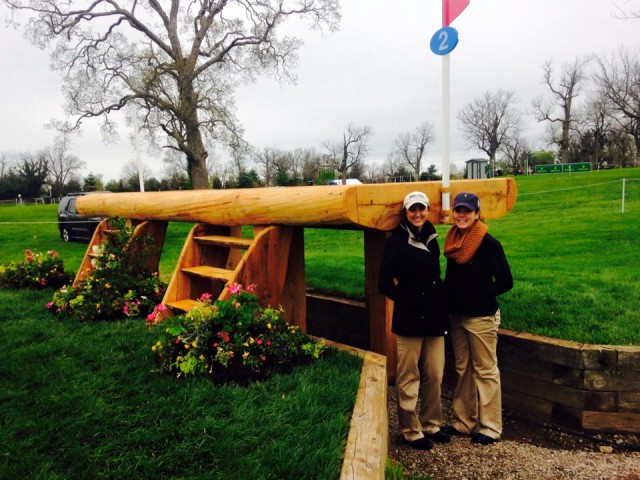A large group of volunteers come together each year to contribute a significant part of what makes the Rolex Kentucky Three-Day Event the world class event that it is. Hayley Sullivan is a first year vet student who worked the vet box at Rolex and was kind enough to share her experience with us.
After unpacking my suitcase and washing my muddy clothes, it’s time to get back to the books.
As a first year veterinary student at Western University of Health Sciences in Southern California, it’s hard to find time to get away. This past weekend however, I snuck off to the Rolex Kentucky Three Day Event for a “school related” trip with my classmate and friend, Maggie.
Out of 58 veterinary student applicants, we were two of the 18 chosen to participate in the American Association of Equine Practitioners Veterinary Student Volunteer Program. We would be working with the best veterinarians in the country on the best event horses in the world, in the D-Box on cross-country day.
As a rider currently competing at the one-star level and a veterinary student who eventually hopes to become an FEI vet, getting selected for this program was a dream come true for me! I had never been to Kentucky or a CCI4* event, so was in for an amazing trip.
On Wednesday, Maggie and I left school and headed for the airport. We arrived to Kentucky at midnight, checked into our hotel and went to bed. The next morning we ignored our jet lag and went on an early morning tour at Rood and Riddle Equine Hospital. We were stunned by the amazing facility and learned about their externships we could do in our later years of school. A tour of Three Chimneys Farm was next on the agenda before heading to the Kentucky Horse Park in the afternoon.
On Friday we enjoyed watching dressage and attended the veterinary briefing in the evening. All veterinarians and veterinary students who would be working cross country attended this briefing. We discussed the logistics of Saturday and the veterinary protocols so that everyone would be prepared. Every veterinarian there was passionate about the sport of eventing and for providing the best care possible for the animals.
What many people may not realize is that there is a veterinarian monitoring each obstacle on the course, just like a jump judge. These vets are there ready to respond with care and communicate with officials about the health of each horse as they go by. The veterinary eyes on these equine athletes could not be any more diligent.
On Friday night all of the students were invited to dinner at Hagyard Equine Medical Institute across the street from the Kentucky Horse Park. We ate while listening to presentations on equine gastric ulcer syndrome and equine lameness before touring the hospital.
Saturday morning we arrived at the D-box an hour before the first horse started. With a forecast of rain throughout the day and thunderstorms in the afternoon, we were in for a wet workday. Three of us worked with Dr. Catherine Kohn at the entrance of the D-box just yards away from the finish flags. We alternated taking temperatures on horses as they came in. Some riders brought their horses to a trot or even a walk before entering the box, and others came in galloping before circling to slow down.
As soon as the rider jumped off, students would take the horse’s temperature and make note of rectal tone (a measure of condition) while Dr. Kohn took heart and respiratory rates. We would also examine the general appearance of the horse and look for any signs of lameness or abrasions. This information was then sent down to the other end of the D-box, where other veterinarians and students would further inspect the horse after grooms cooled them down.
The rider in me loved seeing the reactions of the adrenaline fueled riders as they jumped off their horses and hugged their supporters. The student in me enjoyed making observations about apparent fitness level of horses and comparing that to their vital signs. I also found it interesting to see which horses were wearing FLAIR Equine Nasal Strips on course and how that affected their temperature, pulse and respiration.
I must say, it was also very exciting to be actually touching the horses I had only ever previously seen on my computer while watching big events like the World Equestrian Games and Olympics — even if it was lifting up their tail for a temperature!
Halfway through the start times, another group of students came for their shift. We were free to spend the rest of the day watching rides out on course. We stayed in the viewing tent in the D-box to watch a few rides on the screens while we dried out our clothes and waited for the rain to subside. Then we headed out to be spectators. After all the rides were over, we attended the veterinary debriefing, where we discussed the horses and ways to improve veterinary support for the future.
Sunday morning we watched the second horse inspection while testing our eye for lameness. After an exciting afternoon of show jumping, our weekend had come to a close. Our flight came back to Los Angeles early Monday morning, and we drove straight from the airport to class. Having missed a few days of class, we now have a lot of work to make up.
As I get back in the swing of things on campus, finals are only two weeks away. Although I wish I could be spending my nights watching the cross country helmet camera videos and replay on USEF Network, there is too much to do. Attending Rolex and working alongside the vets gave me the motivation I need to push through until summer. Just two weeks until freedom!



















